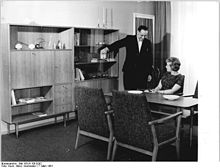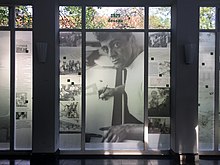Selman Selmanagic
Selman Selmanagić (born April 25, 1905 in Srebrenica , Bosnia ; † May 7, 1986 in East Berlin ) was a Bosnian- German architect and longstanding professor of building and interior design at the Berlin-Weißensee School of Art .
Life
Selmanagić grew up in Bosnia, which was administered by Austria-Hungary in 1876 and occupied in 1908, and in the Kingdom of Yugoslavia from 1918 . After an apprenticeship as a carpenter and his apprenticeship examination, Selman Selmanagić initially worked as a carpenter in the wagon factory in Sarajevo in 1923/24 and made his master's degree as a cabinet maker and furniture maker in 1925 after attending the Ljubljana trade school for a year . This was followed by his military service in 1925/26 . Back in his hometown of Srebrenica, he worked there as a carpenter from 1926 to 1929.
Following his great interest in architecture, he began studying at the Bauhaus in 1929 , which he completed in 1932 with the Bauhaus diploma No. 100, signed by Ludwig Mies van der Rohe and Ludwig Hilberseimer . In order to gain experience, he worked in numerous architecture offices all over Europe and the Middle East until 1939: 1933/35 Istanbul , 1935 Jaffa , 1935–38 Jerusalem , initially as a freelancer for Richard Kauffmann , later as a freelance architect. Study trips took him in 1935/36 to Turkey , Egypt and 1938 to Italy .
In 1939 Selman Selmanagić moved to Berlin. After working as a freelancer at Egon Eiermann , he worked in the construction department from 1939 to 1942 and then as a film architect at UFA until 1945 . During these years he took an active part in the anti-fascist resistance struggle .
After the Second World War, Selmanagić worked in Hans Scharoun's planning collective to develop the “ collective plan ” and later became responsible for planning cultural and recreational sites at the Greater Berlin City Council . In this role he was responsible for the construction of the Walter Ulbricht Stadium . At the same time, from 1945 he was the architect of the VEB Deutsche Werkstätten Dresden-Hellerau . In 1949 Selman heard of the FDJ organization's plans to promote the demolition of the Neue Wache. As an architect, he appealed to the head of the Soviet cultural command, Alexander Lwowitsch Dymschitz . The cultural officer realized that this Schinkel cultural property had to be preserved.
From 1950 until his retirement in 1970 he was head of the architecture department at the Berlin-Weißensee School of Art . Since 1951 he held a professorship for building and interior design there. In 1956, the extension he had planned for the art college in Weißensee was completed. The building ensemble is an important example of post-war modernism in Berlin and is the only remaining building by Selmanagić in Germany.
He was invited to give guest lectures at the Graz University of Technology . In 1950 he became a German and thus received citizenship of the GDR in 1967 .
Selmanagić was married to the architect Emira Selmanagić. The three joint daughters also work as architects.
Honourings and prices
- 1964 Medal of Merit of the GDR
- 1970 Patriotic Order of Merit in bronze
- 1979 Patriotic Order of Merit in Gold
- 1985 Gold Medal for the Patriotic Order of Merit
- 2019 memorial plaque at the art college in Berlin for one of the "most important designers of the GDR"
Works (selection)
- 1931 home for the parents, near Srebrenica
- 1935–1938 residential houses in Jerusalem
- 1946–1950 SED party college "Karl Marx" , Kleinmachnow
- 1957–1950 Administration Academy Forst Zinna
- 1950 Walter Ulbricht Stadium (from 1973 Stadium of World Youth )
- 1956 Extension of the Berlin-Weißensee School of Art in Bühringstrasse
- 1959–1960 Urban planning for Schwedt
- 1975/76 head of restoration work at the Bauhaus Dessau
literature
- Selman Selmanagić, Kunsthochschule Berlin, contributions 10, commemoration for his 80th birthday on April 25, 1985, 72 pp., 66 ills.
- Michael Kasiske: Selman Selmanagic for his 100th birthday. In: Bauwelt 21, April 27, 2005, 96th year
- Aida Abadžić Hodžić, Ines Sonder: A Communist Muslim in the Land of Israel. In: Bauhaus 2, November 2011, 68–75
- Aida Abadžić Hodžić: Selman Selmanagić and the Bauhaus (The Buildings and Art Monuments of Berlin, published by the Landesdenkmalamt Berlin, Supplement 40), Berlin 2018, ISBN 978-3-7861-2794-9
- Selman Selmanagić on bauhaus-online.de (accessed on October 19, 2012)
- Simone Hain: Selmanagic, Selman . In: Who was who in the GDR? 5th edition. Volume 2. Ch. Links, Berlin 2010, ISBN 978-3-86153-561-4 .
Web links
- Catalog raisonné compiled by the Berlin-Weißensee School of Art .
- Azemina Bruch Selmanagić: Contributions to the reconstruction of Berlin. (pdf) April 10, 2018, accessed January 31, 2019 .
Individual evidence
- ↑ Contributions to the reconstruction of Berlin Azemina Bruch Selmanagić, free landscape architect Berliner Denkmaldialog on April 10, 2018 Selman Selmanagić a European biography Bauhaus-Archiv / Museum für Gestaltung, Südhalle Selman Selmanagić after 1945 see lecture with pictures (3.5 MB) p. 11
- ↑ Selmanagic-Symposium 2019. Weißensee Kunsthochschule Berlin, accessed on October 17, 2019 .
- ↑ "GDR designer Selmanagić is honored with a memorial plaque" on welt.de on October 17, 2019
| personal data | |
|---|---|
| SURNAME | Selmanagic, Selman |
| BRIEF DESCRIPTION | German architect |
| DATE OF BIRTH | April 25, 1905 |
| PLACE OF BIRTH | Srebrenica |
| DATE OF DEATH | May 7, 1986 |
| Place of death | Berlin |



